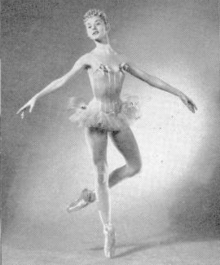Tanaquil Le Clercq
Tanaquil Le Clercq | |
|---|---|
 Le Clercq as Dewdrop of the Candy Flowers in The Nutcracker, 1954 | |
| Born | October 2, 1929 Paris, France |
| Died | December 31, 2000 (aged 71) Manhattan, New York City, New York, U.S. |
| Cause of death | Pneumonia |
| Occupation | Ballet dancer |
| Spouse | |
Tanaquil Le Clercq (/lɛkˈlɛər/ lek-LAIR; October 2, 1929 – December 31, 2000) was a French ballet dancer and principal dancer with the New York City Ballet. Her dancing career ended abruptly when she was stricken with polio in Copenhagen during the company's European tour in 1956.[1] Eventually regaining most of the use of her arms and torso, she remained paralyzed from the waist down for the rest of her life.
Biography
Le Clercq was the daughter of Jacques Le Clercq, a French intellectual, as well as French teacher at Queens College in the 1950s and his American wife, Edith (née Whittemore); she studied ballet with Mikhail Mordkin before auditioning for the School of American Ballet in 1941, where she won a scholarship.[2]
When Le Clercq was fifteen years old, famed choreographer George Balanchine asked her to perform with him in a dance he choreographed for a polio charity benefit. In an eerie portent of things to come (Le Clercq would contract polio at twenty-seven and never recover mobility in her legs), he played a character named Polio, and Le Clercq was his victim who became paralyzed and fell to the floor. Then, children tossed dimes at her character, prompting her to get up and dance again.
Le Clercq was considered Balanchine's first ballerina: she was trained in his style from childhood and she was one of his most important muses, together with dancers like Maria Tallchief and, later on, Suzanne Farrell. During Le Clercq's tenure with the company, Balanchine, Jerome Robbins, and Merce Cunningham all created roles for her.
Years later, after being stricken with polio, she reemerged as a dance teacher and as one student recalled, "used her hands and arms as legs and feet."[citation needed]
Le Clercq's life and career are profiled in the 2013 documentary film, Afternoon of a Faun: Tanaquil Le Clercq.[3]
Personal life
Tanaquil Le Clercq was the fourth and last wife (1952–1969) of George Balanchine, the pioneer of American ballet. He obtained a quick divorce from her to woo Suzanne Farrell (who refused Balanchine's wedding proposal and went on to marry another Balanchine dancer, Paul Mejia).
Le Clercq died of pneumonia in New York Hospital at the age of 71.[4]
Bibliography
- Le Clercq, Tanaquil (1964). Mourka: The Autobiography of a Cat. New York: Stein and Day. ASIN B0007EM4RG.
- Le Clercq, Tanaquil (1966). The Ballet Cook Book. New York: Stein and Day. ASIN B0006BOKE0.
- Acocella, Joan (2007). Twenty-eight Artists and Two Saints: Essays. New York: Pantheon.
Notes
- ^ "Le Clercq contracts polio in Copenhagen". Time. 14 February 1969. ISSN 0040-781X.
- ^ "Profile of Tanaquil Le Clercq". Ballet Encyclopedia. Retrieved 14 April 2014.
- ^ Holden, Stephen (April 2014). "Afternoon of a Faun: Tanaquil Le Clercq (2013)". The New York Times.
- ^ Kisselgoff, Anna (1 January 2001). "Tanaquil Le Clercq, 71, Ballerina Who Dazzled Dance World". The New York Times.
References
- Shell, Marc (2005). Polio and its aftermath: the paralysis of culture. Cambridge: Harvard University Press. ISBN 0-674-01315-8.
- Brubach, Holly; Lassalle, Nancy; Bourscheidt, Randall; Martins, Peter (2004). Tanaquil Le Clercq 1929-2000. New York: Eakins Press Foundation.
